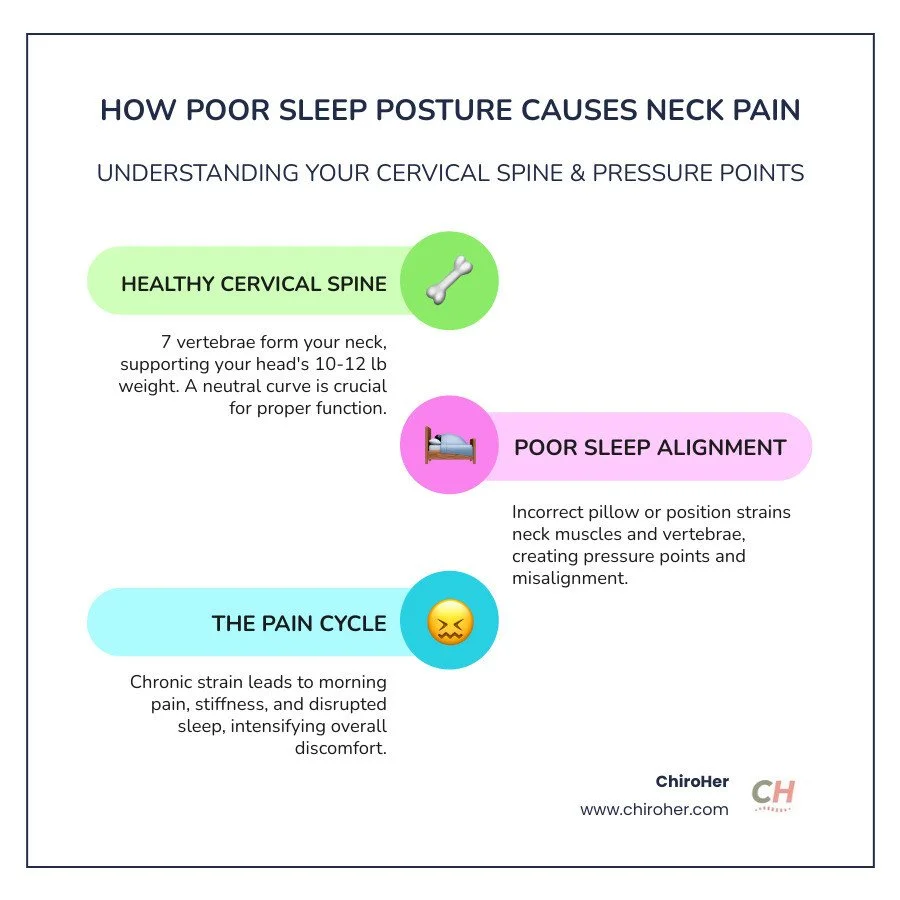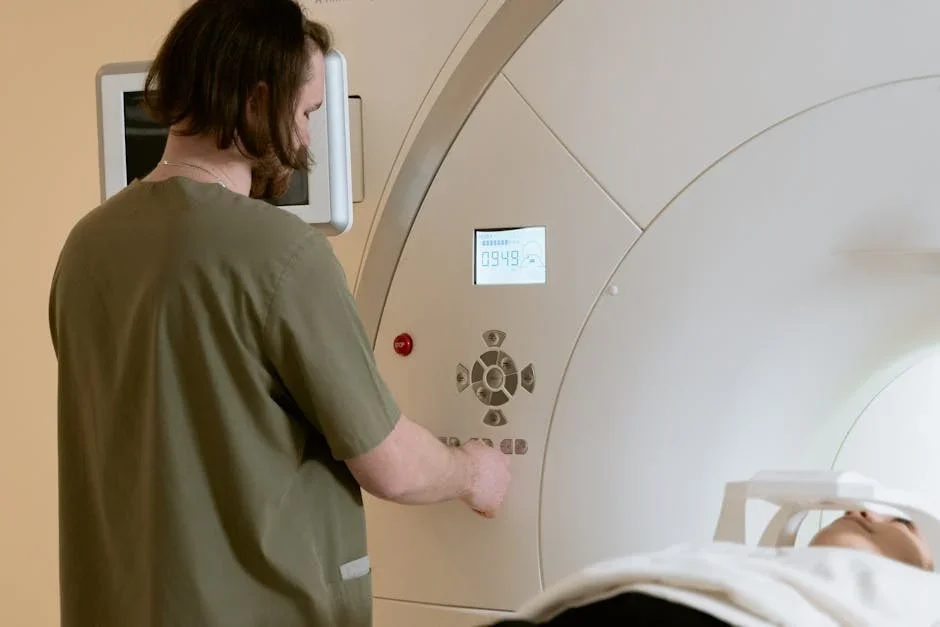Conquer Neck Pain in Your Sleep: Tips for Restful Nights
Why Cervical Neck Pain Disrupts Your Sleep
Learning how to sleep with cervical neck pain can transform your nights from restless tossing to peaceful rest. Research shows that neck pain affects 10-20% of adults. This creates a frustrating cycle: poor sleep worsens neck pain, and neck pain prevents quality sleep.
Quick Solutions for Tonight:
Sleep on your back or side, and avoid stomach sleeping.
Use a pillow with the proper height: medium for back sleepers, tall for side sleepers.
Maintain neutral spine alignment, with your ears over your shoulders and shoulders over your hips.
Apply heat or cold therapy for 15-20 minutes before bed.
Try gentle neck stretches to release muscle tension.
Waking up with neck pain disrupts your entire day. A dull ache, shooting pain, or loss of mobility can interfere with work, driving, and daily activities.
The cervical spine has seven vertebrae that support your head's weight, which is about 10-12 pounds. During sleep, poor positioning can strain these delicate structures for hours. Research from Harvard Medical School confirms that proper sleep posture is critical for neck pain relief.
I'm Dr. Michelle Andrews, founder of ChiroHer in Oklahoma City, and I've helped hundreds of patients find relief from neck pain through personalized chiropractic care. My experience treating cervical spine issues has shown me that understanding how to sleep with cervical neck pain is often the first step toward lasting relief.
How to Sleep with Cervical Neck Pain for a Better Morning
Waking up with a stiff, aching neck doesn't have to be your reality. Learning how to sleep with cervical neck pain involves small changes to your habits that can make a huge difference. Your cervical spine supports your head all day and needs proper rest at night. The key is creating the right conditions for healing through position, support, and preparation before bed.
Finding the Best Sleeping Position for Your Neck
Your sleeping position is foundational for neck health. The goal is to maintain a neutral spine, where your ears are aligned over your shoulders and hips. This prevents your neck muscles from straining while you sleep.
Back sleeping is often best for spinal health. It allows your spine to maintain its natural curves. Placing a small pillow under your knees can further support your lower back and neck. Use a pillow that cradles your neck's curve, keeping your head from being pushed too far forward or dropping back.
Side sleeping is also a good option. Use a taller, firmer pillow to fill the space between your neck and the mattress, keeping your head level with your spine. A pillow between your knees will help keep your spine aligned. Try to alternate sides to avoid muscle imbalances.
Stomach sleeping is the worst position for your neck. It forces you to twist your head for hours, straining muscles and potentially compressing nerves. We strongly advise against it. To transition away from stomach sleeping, use pillow barriers or a body pillow to encourage back or side sleeping.
For severe pain, sleeping slightly reclined with a wedge pillow or in a recliner may offer relief by reducing pressure on nerves.
Understanding proper sleep positioning is crucial for managing neck pain, especially if you're dealing with issues like tech neck from daily computer use. You can learn more about tech neck pain and how it affects your sleep comfort.
Choosing the Right Pillow and Mattress
Your pillow and mattress work together to support your spine. The right combination is a game-changer for anyone learning how to sleep with cervical neck pain.
Pillow loft, or height, is critical. A pillow that's too high or too low will strain your neck. Back sleepers generally need medium-height pillows, while side sleepers need taller ones to fill the space between the ear and shoulder.
Memory foam pillows mold to your shape, offering customized support. Cervical pillows are contoured with a raised area to support your neck's natural curve. One supportive pillow is the goal. If you're stacking pillows, your main pillow isn't providing enough support.
Your mattress is the foundation. A medium-firm mattress usually offers the best balance of comfort and support, preventing your spine from sinking. An old, sagging mattress undermines even the best pillow. Mattress firmness is about spinal support. A mattress that has lost its support can cause your entire spine to suffer, leading to morning neck pain.
Investing in quality sleep surfaces is investing in your health. Poor sleep setup is often a major contributor to morning neck stiffness, which you can read more about in our guide on stiff neck pain in the morning.
Pre-Sleep Routines to Soothe Neck Pain
A pre-sleep routine can signal your neck muscles to relax and heal, improving comfort and sleep quality.
Heat therapy (heating pad or warm towel for 15-20 minutes) increases blood flow and eases muscle tension. Cold therapy (cold pack for 15-20 minutes) is best for acute pain and inflammation, as it reduces swelling. Some people alternate between heat and cold.
Gentle neck stretches can release tension. Never force a stretch, and stop if you feel sharp pain.
Neck rotations: Slowly turn your head right, hold for 5-10 seconds, return to center, then left.
Ear-to-shoulder stretches: Gently tilt your ear toward your shoulder, feeling a mild stretch along the opposite side of your neck.
Gentle head nods: Slowly bring your chin toward your chest, then carefully look up slightly.
Shoulder rolls: Rolling your shoulders forward and backward helps release tension in your upper back.
Relaxation techniques address the mental component of pain. Stress increases muscle tension. Try deep breathing exercises by placing one hand on your chest and one on your abdomen, and focus on slow, deep breaths.
A proper sleep environment is also important. Keep your bedroom cool, dark, and quiet. Maintain a consistent sleep schedule and limit pre-bed screen time, as blue light disrupts sleep hormones. A warm bath or shower before bed can also help by relaxing muscles and signaling that it's time to sleep.
These pre-sleep routines are particularly important if you're dealing with neck-related headaches. Learn more about the connection between headache and neck stiffness and pain.
Beyond the Bedroom: Long-Term Strategies and When to Seek Help
Mastering how to sleep with cervical neck pain is important, but it's only part of the solution. Daily habits and professional help are also vital for lasting relief.
How to Adjust Your Habits for Lasting Relief
Neck pain is often a signal that something is wrong with your daily habits, not just your sleep. Small changes to your routine can significantly improve how your neck feels at night.
Posture: Your Neck's Best Friend or Worst Enemy
Your daytime posture affects how you feel at night. Slouching or craning your neck forward creates muscle tension that carries over to bedtime. Keep your ears aligned over your shoulders. When sitting, imagine a string pulling your head toward the ceiling to help straighten your spine.
The Modern Plague: Tech Neck
"Tech neck" results from constantly looking down at screens. This forward head posture puts immense strain on your cervical spine, adding up to 60 pounds of pressure. The solution is to bring devices to eye level. Position your monitor with the top of the screen at or just below eye level. Hold phones and tablets higher, and take frequent stretch breaks.
You can learn more about this common issue in our article about tech neck pain.
Movement: The Magic Medicine
Your neck isn't meant to stay in one position for hours. Regular movement prevents stiffness. Get up hourly to walk and reset your posture. Incorporate micro-breaks for gentle neck rolls, shoulder shrugs, and upper back stretches to prevent tension buildup.
Small Changes, Big Results
Start with one small habit, like adjusting your monitor or setting movement reminders. Consistency is key.
For more comprehensive information about how chiropractic care can support these lifestyle changes, check out our article on chiropractic for neck pain.
How to Sleep with Cervical Neck Pain: Recognizing Red Flags
Most neck pain is temporary and resolves with self-care. However, sometimes it signals a more serious issue. Knowing when to seek professional help is important.
Seek medical attention for neck pain that lasts more than a few weeks despite self-care. Persistent pain that disrupts your daily life or sleep requires professional evaluation. Also, see a professional if the pain worsens.
The Nerve Warning Signs
Never ignore symptoms of nerve involvement. Seek immediate attention for:
Numbness or tingling in your arms, hands, or fingers.
Weakness in your arms or hands, such as trouble gripping objects.
Shooting pain that travels down your arm. This often indicates nerve compression.
After an Injury: Better Safe Than Sorry
Get checked out if your neck pain started after an accident, fall, or injury, even if it seems mild. Early treatment can prevent future complications.
The Bigger Picture Symptoms
Urgent medical attention is needed if neck pain is accompanied by:
Fever or severe headache
Nausea or vomiting
Changes in coordination or balance
According to scientific research on neck pain symptoms, understanding these warning signs helps ensure you get the right care at the right time.
The Long-Term Cost of Poor Sleep Posture
Consistently poor sleep posture can lead to long-term problems beyond morning stiffness, including accelerated wear on your cervical spine, chronic pain, and nerve compression. Addressing these issues early through better habits or professional care can prevent these long-term complications.
How Our Chiropractic Care Can Help Your Neck Pain
At ChiroHer, we know that learning how to sleep with cervical neck pain is just one piece of the puzzle. We address the root causes of your discomfort for lasting relief and better sleep.
Why We're Different
As a boutique clinic in Oklahoma City, we offer personalized chiropractic, acupuncture, and holistic wellness services. We provide award-winning, patient-focused care, especially for women and prenatal clients, in an upscale, comfortable setting. We serve patients throughout the Oklahoma City metro area, including Yukon, Edmond, Nichols Hills, Del City, Mustang, and Moore.
Our Comprehensive Approach
We start with a thorough evaluation, including spinal x-rays when needed, to understand your unique situation. Our gentle spinal adjustments restore proper cervical spine alignment, reducing pressure on nerves and promoting natural healing. Many patients report improved pain levels and sleep quality soon after starting care.
Breaking the Pain-Sleep Cycle
Neck pain and poor sleep create a frustrating cycle. Our targeted chiropractic care helps break this cycle. As pain decreases and sleep improves, your body can heal more effectively. Our personalized care plans can include spinal adjustments, therapeutic exercises, lifestyle guidance, and acupuncture for pain relief.
Your Next Step Toward Better Sleep
If you're tired of waking up with neck pain, we're here to help you achieve the restful sleep you deserve.
Ready to take the next step? Schedule a consultation with our neck pain chiropractor in OKC to get started with pain-free mornings. You can also learn more about our comprehensive chiropractic care services and find the 5 benefits of chiropractic care that can transform your health and well-being.
Trusted research and sources for neck pain and sleep
Use these reputable resources to explore the evidence behind sleep positions, pillow choice, red flags, and self-care strategies:
Harvard Health Publishing: Best sleep positions and spinal alignment https://www.health.harvard.edu/pain/what-is-the-best-sleep-position
American Academy of Family Physicians: Neck pain evaluation and management, including red flags https://www.aafp.org/pubs/afp/issues/2020/0801/p150.html
American Academy of Sleep Medicine: Healthy sleep habits to improve sleep quality https://aasm.org/healthy-sleep/healthy-sleep-habits/
National Center for Complementary and Integrative Health: Heat and cold therapy for pain relief https://www.nccih.nih.gov/health/heat-and-cold-therapy-for-pain-relief
Mayo Clinic: Neck pain symptoms and causes https://www.mayoclinic.org/diseases-conditions/neck-pain/symptoms-causes/syc-20375581
NIOSH (CDC): Ergonomic tips for computer work to reduce neck strain https://www.cdc.gov/niosh/topics/ergonomics/
This guide is for informational purposes and is not a substitute for professional medical advice from your healthcare provider.





